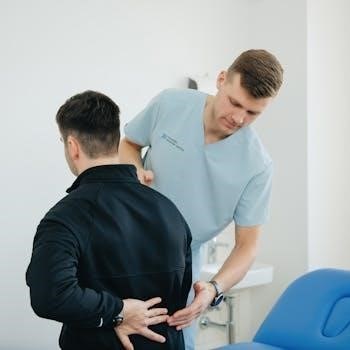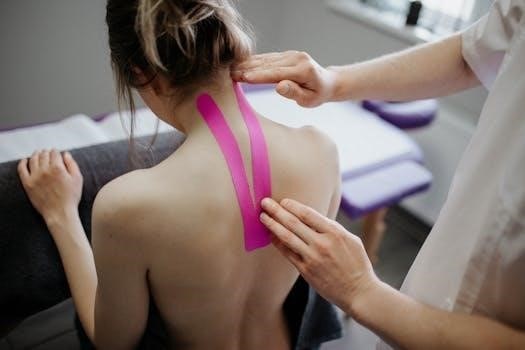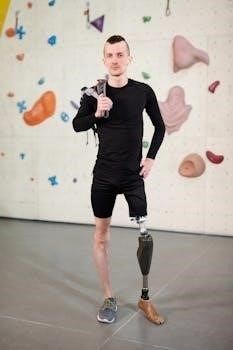Patella Fracture Rehabilitation⁚ A Comprehensive Guide
This guide provides a structured overview of patella fracture rehabilitation. It covers essential aspects from initial immobilization and early range of motion‚ to quadriceps strengthening and advanced exercises. The guide also addresses weight-bearing progression‚ brace usage‚ return-to-sport considerations‚ and potential complications‚ aiding comprehensive recovery.
Initial Immobilization and Weight-Bearing (0-2 Weeks)
The first two weeks following a patella fracture are crucial for initial healing and stability. Immobilization is typically achieved using a knee immobilizer‚ often locked in full extension‚ to protect the healing bone. Weight-bearing during this phase is usually “weight-bearing as tolerated” (WBAT) with the knee locked in extension‚ allowing some ambulation while minimizing stress on the patella. Range of motion (ROM) is generally restricted to prevent displacement‚ often allowing only 0-30 degrees of assisted or passive movement.
Therapeutic exercises during this period focus on maintaining muscle activation without stressing the fracture site. Quadriceps sets‚ isometric exercises for hip abduction‚ adduction‚ and extension are common. The goal is to minimize muscle atrophy and promote circulation. Patellar mobilization is initiated gently to prevent stiffness. It’s important to follow the specific instructions of your surgeon and physical therapist‚ as protocols may vary based on the fracture type and fixation method used. Regular follow-up appointments are essential to monitor healing progress and adjust the rehabilitation plan accordingly.

Early Range of Motion Exercises (0-4 Weeks)
The period from weeks 0 to 4 post-patella fracture is critical for regaining knee mobility while protecting the healing bone. Early range of motion (ROM) exercises are initiated to minimize stiffness‚ prevent scar tissue formation‚ and promote cartilage health. A hinged knee brace is often utilized‚ allowing controlled flexion and extension within a prescribed range‚ typically progressing from 0-30 degrees initially to a greater range as healing advances. Active-assisted and passive ROM exercises are emphasized to gently restore movement.
Patellar mobilization is continued to prevent the patella from adhering to surrounding tissues‚ ensuring smooth tracking during knee movement. Exercises may include gentle gliding of the patella in various directions. It’s crucial to avoid aggressive movements that could compromise fracture stability. Quadriceps sets and other isometric exercises continue to maintain muscle activation and strength. Close monitoring by a physical therapist is essential to ensure proper technique and prevent complications. Progression should be guided by pain levels and radiographic evidence of healing‚ ensuring a gradual and safe return to functional movement.
Quadriceps Strengthening Exercises
Quadriceps strengthening is a cornerstone of patella fracture rehabilitation‚ crucial for restoring knee stability and function. These exercises aim to rebuild muscle mass and strength lost due to immobilization and surgery. Initially‚ isometric quadriceps sets are performed‚ involving tightening the thigh muscles without joint movement. As healing progresses‚ active exercises are introduced‚ such as straight leg raises (SLRs)‚ focusing on maintaining a fully extended knee during the lift. Short-arc quadriceps exercises‚ performed within a limited range of motion‚ further engage the quadriceps while minimizing stress on the patella.
Resistance can be gradually added using weights or resistance bands to increase the challenge. Proper form and controlled movements are paramount to prevent re-injury. Exercises should be performed through the full available range of motion as healing allows‚ aiming to achieve equal strength and endurance compared to the uninjured leg. Close monitoring by a physical therapist is essential to ensure appropriate progression and address any pain or limitations. The ultimate goal is to regain sufficient quadriceps strength for functional activities and return to sport or daily life.
Patellar Mobilization Techniques
Patellar mobilization techniques are essential for restoring normal patellar movement following a fracture‚ preventing stiffness and improving knee function. These manual therapy techniques involve gentle gliding and tilting of the patella in various directions (superior‚ inferior‚ medial‚ and lateral) to break up adhesions and improve joint mobility. The primary goal is to restore pain-free range of motion and allow for optimal quadriceps function.
These techniques should be performed by a skilled physical therapist who can assess the patellar tracking and identify any restrictions. Mobilization exercises should be started early in the rehabilitation process‚ typically within the first few weeks‚ as tolerated. The therapist will use their hands to apply controlled forces to the patella‚ gradually increasing the intensity as healing progresses. Patient feedback is crucial during these sessions to ensure comfort and avoid over-stressing the healing tissues. Regular patellar mobilization can significantly enhance overall recovery and improve long-term outcomes after a patella fracture.
Weight-Bearing Progression
Weight-bearing progression after a patella fracture is a carefully managed process designed to gradually increase the load placed on the healing bone and surrounding tissues. The initial phase typically involves non-weight-bearing or touch-down weight-bearing‚ where minimal weight is placed on the affected leg; This allows for initial healing and reduces the risk of re-injury. As healing progresses‚ weight-bearing is gradually increased‚ often following a prescribed protocol.
Progression from partial weight-bearing to full weight-bearing depends on factors such as fracture stability‚ pain levels‚ and quadriceps muscle strength. Physical therapists monitor these factors closely to ensure safe and effective progression. Assistive devices like crutches or a walker are commonly used during the early stages to provide support and reduce stress on the knee joint. Weight-bearing exercises‚ such as controlled squats and step-ups‚ are introduced as tolerance improves‚ further enhancing strength and stability. Adhering to the prescribed weight-bearing schedule is crucial to prevent complications and promote optimal healing.
Use of Knee Brace and Immobilizer
Following a patella fracture‚ a knee brace or immobilizer plays a crucial role in protecting the healing bone and surrounding soft tissues. Initially‚ an immobilizer is often used to keep the knee in full extension‚ preventing movement and promoting bone union. This is typically worn at all times‚ except during physical therapy sessions‚ to provide consistent support and stability. The duration of immobilizer use varies depending on the severity and stability of the fracture‚ but it generally lasts for the first few weeks post-injury or surgery.
As rehabilitation progresses‚ the immobilizer may be replaced with a hinged knee brace. This type of brace allows for controlled range of motion‚ enabling early mobilization while still providing protection. The range of motion is gradually increased over time‚ guided by the physical therapist and the patient’s tolerance. The knee brace supports weight-bearing activities and protects against excessive stress on the patella. Proper fitting and adjustment of the brace are essential to ensure comfort‚ stability‚ and optimal healing. The use of a knee brace is gradually weaned off as strength and stability improve‚ eventually allowing for brace-free activities.
Isometric Exercises
Isometric exercises are a foundational element in the early stages of patella fracture rehabilitation. They involve contracting muscles without changing their length or moving the joint. These exercises are crucial because they help activate and strengthen the muscles around the knee without placing undue stress on the healing fracture site. Isometric exercises minimize the risk of re-injury while promoting muscle activation and preventing atrophy.
Common isometric exercises for patella fracture rehabilitation include quadriceps sets‚ hamstring sets‚ and adductor/abductor squeezes. Quadriceps sets involve tightening the thigh muscles while keeping the leg straight. Hamstring sets involve pressing the heel into the ground while keeping the knee slightly bent. Adductor/abductor exercises can be performed by squeezing a pillow between the knees or pressing the outer thighs against a stable surface. Each contraction should be held for several seconds‚ followed by a period of relaxation. These exercises can be performed multiple times throughout the day‚ gradually increasing the duration and intensity as tolerated. Isometric exercises lay the groundwork for subsequent dynamic strengthening exercises.

Hamstring Strengthening
Hamstring strengthening is an integral part of patella fracture rehabilitation‚ crucial for restoring knee stability and function. While quadriceps strengthening is often the primary focus‚ balanced rehabilitation requires equal attention to the hamstrings. Strong hamstrings help control knee extension‚ protect the healing patella‚ and contribute to overall lower limb strength. Neglecting hamstring strengthening can lead to muscle imbalances‚ increased stress on the knee joint‚ and potential re-injury.
Hamstring strengthening exercises typically begin with isometric holds and gradually progress to dynamic movements as healing allows. Early exercises may include isometric hamstring sets‚ where the heel is pressed into the ground with the knee slightly bent. As strength improves‚ exercises like hamstring curls with resistance bands or light weights can be introduced. Progressing further‚ functional exercises such as bridges and single-leg deadlifts help improve hamstring strength and stability in weight-bearing positions. Throughout the rehabilitation process‚ it’s important to monitor for any pain or discomfort and adjust the exercises accordingly. Proper hamstring strength is essential for a successful return to full activity and sports.
Advanced Strengthening Exercises (Weeks 6+)
Beginning around week six‚ advanced strengthening exercises become a crucial component of patella fracture rehabilitation‚ aiming to restore full strength‚ power‚ and functional capacity to the injured leg. This phase focuses on progressively challenging the knee joint and surrounding muscles to prepare for higher-level activities and a return to sport. Before initiating these exercises‚ ensure adequate healing and range of motion have been achieved.
Advanced exercises may include weighted squats‚ lunges‚ leg presses‚ and step-ups‚ gradually increasing the weight and repetitions as tolerated. Balance and proprioception exercises‚ such as single-leg stands and wobble board activities‚ are also incorporated to improve stability and coordination. Plyometric exercises‚ like jump squats and box jumps‚ can be introduced to enhance power and explosiveness. Throughout this phase‚ close monitoring for any signs of pain or swelling is essential‚ and exercises should be modified or regressed if necessary. The goal is to progressively overload the muscles while ensuring proper form and minimizing the risk of re-injury‚ ultimately leading to a successful return to pre-injury activity levels. Consistency and adherence to the prescribed exercise program are key to achieving optimal outcomes.

Return to Sport/Activity Considerations
Returning to sport or high-level activity following a patella fracture requires careful consideration and a structured approach; This phase is not solely based on time elapsed but rather on achieving specific functional milestones‚ ensuring the knee can withstand the demands of the intended activity. A comprehensive assessment should include strength testing‚ range of motion evaluation‚ and functional performance tests‚ such as hopping‚ jumping‚ and agility drills.
Before returning‚ the individual must demonstrate adequate quadriceps and hamstring strength‚ comparable to the uninjured leg. Full‚ pain-free range of motion is essential‚ and any swelling or discomfort should be minimal. Functional testing should mimic the specific movements required in the sport or activity‚ gradually increasing intensity and complexity. A progressive return-to-sport program‚ guided by a physical therapist or sports medicine professional‚ is crucial. This program should involve a gradual increase in training volume and intensity‚ with close monitoring for any signs of re-injury. Psychological readiness is also a key factor; the individual must feel confident and comfortable performing the necessary movements. Ultimately‚ the decision to return to sport should be a collaborative one‚ involving the individual‚ physical therapist‚ physician‚ and coach‚ ensuring a safe and successful transition back to activity.
Potential Complications and Management
Patella fractures‚ despite successful surgical or non-surgical management‚ can present with potential complications that require prompt recognition and appropriate intervention. Knee stiffness is a common issue‚ often resulting from scar tissue formation and prolonged immobilization. Management involves aggressive range of motion exercises‚ patellar mobilization techniques‚ and‚ in some cases‚ arthroscopic lysis of adhesions. Pain‚ another frequent complication‚ can stem from hardware irritation‚ arthritis‚ or nerve injury. Addressing pain may involve medication‚ physical therapy‚ or‚ if hardware is the cause‚ eventual removal.

Nonunion or malunion of the fracture fragments can also occur‚ leading to persistent pain‚ instability‚ and altered biomechanics. These situations may necessitate further surgical intervention to achieve proper alignment and stability. Post-traumatic arthritis is a long-term complication that can develop due to cartilage damage sustained during the initial injury. Management focuses on pain relief‚ activity modification‚ and potentially joint replacement in severe cases. Quadriceps weakness and atrophy are common‚ requiring targeted strengthening exercises and neuromuscular re-education. Finally‚ infection is a rare but serious complication‚ particularly following open fractures or surgical procedures. Prompt antibiotic treatment and potentially surgical debridement are essential to manage infection effectively. Close monitoring and proactive management strategies are vital to minimize the impact of these potential complications and optimize long-term outcomes.
